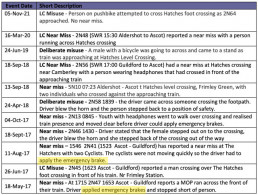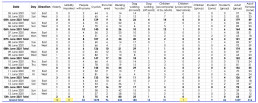Network Rail have identified The Hatches crossing as high risk. There have been 11 recorded instances on this crossing in the last 5 years.
7 of the 11 instances are considered as a near miss. A near miss is classified by the train driver applying the emergency brakes, although this is only mentioned on two of the incident details.
According to Network Rail, the crossing has approximately 300 daily users with a large number of cyclists. Network Rail have also been keen to highlight groups such as “hoodie wearers”, fisherman, people with prams and dog walkers. No information has been provided to understand the motives of the users and where they are travelling to and from.
Whistle boards and audible warnings (horns) are used by approaching trains to notify users that a train is approaching.
Concerns raised
In the Narrative Risk Assessment – Incident history (2.10), there are eleven incidents listed over a four year period. Only two of these have occurred in the final two years period.
Of these eleven, only two reference needing to apply the emergency brake and they were both five years ago. On this basis, who decides what is considered a near miss / deliberate misuse? Surely this is subjective and could lead to crossings being classified based the opinion of drivers.

In the Narrative Risk Assessment – Crossing Usage (2.8), some information is provided about users but the census was conducted in a period when the country was recovering from the Coronavirus restrictions. On this basis, how true a reflection is this of pre or post pandemic?
Network Rail have shared no evidence to determine the motivations of the crossing users. No surveys or attempts to engage have been performed. Network Rail asserts around 300 crossings per day. For example, how many of these users are walkers or cyclist on a 10km circular route for whom a brief diversion via Frimley & Blackwater Valley path would be insignificant? How many of the crossers start and end their journeys in locations where the additional distance of travelling to Farnborough via Frimley or Hamesmoor Road would be deemed insignificant?
A proper survey of the users post pandemic is surely required to establish this before committing to such a huge and disruptive project.
In 2.8.7 it states “The types of vulnerable users are elderly, unaccompanied children, mobility impaired”, but when looking at the table of data, there are just thirteen elderly, one unaccompanied child and zero mobility impaired users over a nine day period. It’s difficult to understand why these groups are being emphasised.

Fishermen are referenced on multiple occasions in the risk assessment. Whenever residents have raised concerns over fishermen parking, Network Rail have been keen to raise the point that won’t be an issue due to improved parking arrangements with the fishery. On that basis, including them in this report becomes irrelevant… or if there will continue to be fishermen using the crossing, the issue of parking needs to be addressed – Network Rail can’t pick and choose when to include them to support their argument.
Some of the visuals used in the Narrative Risk Assessment are misleading.
The images of a “reckless” crosser in the snow are time stamped and were taken on a day when the train line was closed.

Images of distracted / encumbered users in the consultation presentations are also difficult to substantiate. Network Rail have no way to determine if users wearing headphone have them turned on and if people wearing hoods are looking before they step out.
Do you oppose Network Rail's bridge proposal?
If you don’t agree with what Network Rail are proposing, there are things you can do.
Doing nothing will be seen as a positive response by Network Rail.
